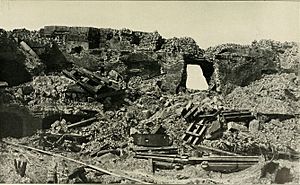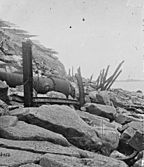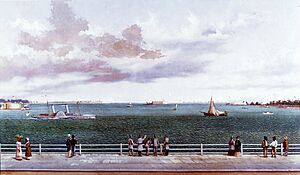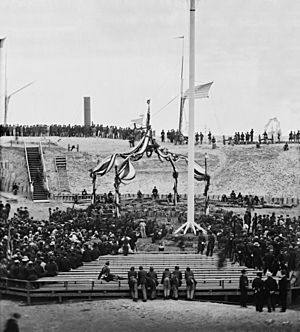Second Battle of Fort Sumter facts for kids
Quick facts for kids Second Battle of Fort Sumter |
|||||||
|---|---|---|---|---|---|---|---|
| Part of the American Civil War | |||||||
 Photograph taken September 8, 1863, shows the breach compromised at Fort Sumter's wall facing Morris Island during bombardment of Fort Sumter. The naval party attempted to enter the fort here. |
|||||||
|
|||||||
| Belligerents | |||||||
| Commanders and leaders | |||||||
| Quincy Gillmore | P. G. T. Beauregard | ||||||
| Strength | |||||||
| 413 | 320 | ||||||
| Casualties and losses | |||||||
| 117 | 9 | ||||||
The Second Battle of Fort Sumter happened on September 8, 1863, in Charleston Harbor. This battle was part of the American Civil War. Confederate General P. G. T. Beauregard was in charge of the fort's defense. He had also led the Confederates when they captured Fort Sumter at the start of the war.
In this second battle, Union forces tried to take the fort back. They were led by Major General Quincy Adams Gillmore. Union cannons fired heavily at the fort from their positions on Morris Island. After a strong attack, Beauregard replaced his artillery (cannon) crews with 320 infantry soldiers. These soldiers successfully stopped a Union naval landing party. General Gillmore had turned Fort Sumter into ruins, but the Confederate flag still flew over it.
What Led to the Battle
The Union army wanted to take back Charleston Harbor. Their first big attempt was on April 7, 1863. Rear Admiral Samuel Francis Du Pont led a group of powerful ironclad ships. These ships included the New Ironsides, Keokuk, and several Monitor-class ships.
This attack did not work. The Union's best ship, USS New Ironsides, didn't get into the fight properly. The ironclads fired only 154 shots, while the Confederates fired over 2,200 back. The USS Keokuk was badly damaged and sank the next day. Over the next month, Confederates secretly pulled two large cannons from the sunken Keokuk. One of these cannons was then placed in Fort Sumter.
Meanwhile, the Confederates were making Fort Sumter stronger. Nearly 500 enslaved people worked under Confederate engineers. They filled parts of the fort with sand and built new protections. Some of the fort's cannons had been moved, but 40 still remained. The heaviest cannons were on the top level, called the barbette. This gave them a wide view to fire at ships, but it also made them more open to enemy fire.
A special award, called the Gillmore Medal, was later given to Union soldiers who served at Fort Sumter under General Gillmore.
The Battle Begins
After the Union's heavy shelling, both Major General Quincy Adams Gillmore and Rear Admiral John A. Dahlgren decided to attack Fort Sumter by boat. This attack was planned for the night of September 8–9, 1863. However, the Army and Navy did not work well together. Admiral Dahlgren refused to let his sailors and marines be led by an army officer.
So, two separate groups of boats set out for Fort Sumter that night. The army's boats were delayed by low tide. By the time they could move, the navy's attack had already failed. The army boats then returned to shore.
The navy's attack involved 400 sailors and marines in 25 boats. The whole operation was a disaster. There was bad scouting, poor planning, and little communication. Commander Thomas H. Stevens, Jr. was put in charge of the attack. He protested, saying he knew nothing about the plan. Admiral Dahlgren told him, "There is nothing but a corporal's guard [about 6–10 men] in the fort, and all we have to do is go and take possession."
Dahlgren greatly underestimated the Confederate forces. This might be why he didn't want the Army to join the attack. Less than half of the boats actually landed. Most of the boats that did land ended up on the wrong side of the fort. The Union sailors and marines who landed could not climb the fort's walls.
The Confederates fired at the landing party and threw hand grenades and loose bricks. The men in the boats that hadn't landed fired their guns blindly at the fort. This put the landing party in more danger than the Confederates. The landing party took cover in holes in the fort's wall. When the Confederates fired a signal rocket, Fort Johnson and the Confederate warship CSS Chicora also began firing. The boats that could, left, and the landing party surrendered. The Union suffered 8 killed, 19 wounded, and 105 captured. The Confederates had no casualties in this attack.
What Happened Next
After the boat attack failed, the Union continued to bombard Fort Sumter. The shelling went on with different levels of force until the end of the American Civil War. The Confederate soldiers inside the fort continued to suffer casualties.
The Confederates kept taking cannons and other supplies from the ruins of the fort. They also used sharpshooters to bother the Union cannons on Morris Island. They managed to set up more cannons in the fort's lower levels.
The last Confederate commander, Major Thomas A. Huguenin, never officially surrendered Fort Sumter. However, General William T. Sherman's march through South Carolina forced the Confederates to leave Charleston on February 17, 1865. This meant they had to abandon Fort Sumter. The United States government officially took control of Fort Sumter on February 22, 1865, with a flag-raising ceremony. One Union soldier was killed and another was badly wounded during this ceremony. Fifty-two Confederate soldiers died at the fort during the rest of the war. Many enslaved people also died while working at the fort, but the exact number is not known.
Images for kids
See also
 In Spanish: Segunda batalla de Fort Sumter para niños
In Spanish: Segunda batalla de Fort Sumter para niños









